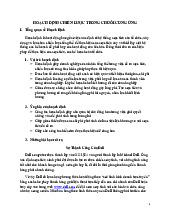



Preview text:
JAPAN'S GREEN PUBLIC PROCUREMENT EXPERIENCE AND LESSONS FOR VIETNAM
Authors: Cu Hoang Lam Vu, Vu Anh Quan
Mentor: TS. Nguyen Anh Quang
Academy of Finance ABSTRACT
This research concentrated on the experience of green public procurement activities in Japan and precious
lessons that Vietnam could learn from. Technology and industrial advancement have greatly contributed
to the economic growth of both countries. However, it also causes a lot of environmental issues and
pollution. Japan has put a series of green-public-procurement measures so as to reduce detrimental
environmental impacts and encourage sustainable development. The research finds out the policies,
regulations and mechanisms that Japan had set up to promote green public procurement activities in
public agencies and organizations. Besides, it also considers the specific steps that enterprises and
individuals can take to participate in this model of green public procurement activities.
Keywords: experience, green public procurement activities, issues, measures 1. Introduction
In this day and age, environmental pollution, climate change, resource depletion have become global
challenges, thereby posing threats to the existence and development of mankind. Therefore, the governing
bodies of different countries have been actively putting measures into practice with an aim of building a
resilient, circular and environmentally-friendly economy. One of the most effective solutions is to promote
green public procurement. Green public procurement is a process whereby organizations meet their needs for
goods, services, works and utilities in a way that achieves value for money on a life-cycle basis while
addressing equity principles for sustainable development, therefore benefiting societies and the environment
across time and geographies. Having been aware of the positive values that green public procurement
brought, Japan - a nation with limited resources and often influenced by climate change - has paid special
attention and obtained numerous achievements in this field. For that reason, Japan is one of the most
advanced countries in applying green public procurement, with a lot of experience that Vietnam can learn from.
2. Literature review
2.1. Current situation and achievements of green public procurement activities in Japan
Currently, Japan is one of the most developed in green public procurement activities. According to
the governmental report of Japan in 2020, the proportion of green technology products and services in public
procurement activities of governmental units of Japan was 23,5%, increasing from 22,7% in 2019. Energy-
saving products and services took the highest proportion of 14,6%, followed by products and services that
reduce carbon emissions stood at 4,3%.
Governing bodies of Japan set a goal to increase the percentage of green technology products and
services to 30% and 50% in 2030 and 2050 respectively. Besides, Japanese enterprises and organizations are
actively participating in green public procurement with an aim to reduce negative effects on the environment
and promote competitiveness between businesses.
Green technology products and services have been widely used in various fields in Japan, including
the activities of local authorities, enterprises, organizations and families. Popular green technology products
and services in Japan consist of energy-saving products and services; carbon-reduction products and
services; products and services using renewable energy sources; products and services which reduce waste
and smart city products and services. Green public procurement in Japan has created many environmental
benefits, minimized expenses and provided new business chances for enterprises and organizations. The total
value of green-public-procurement contracts of Japanese governmental entities in fiscal year 2019 was
approximately 2,2 million dollars, which was 10% higher than the previous year. Green technology products
and services are being widely used in construction projects in Japan, including office buildings, hotels,
restaurants and other public buildings. Green technology products and services which are used in these
buildings include energy-saving equipment, smart air-conditioning systems, energy-saving lighting systems
and other devices. Enterprises in Japan are also actively participating in green public activities. with the goal
of boosting the competitiveness between businesses and minimizing the impact on the environment.
According to a report by the Japanese Ministry of Economy, Trade and Industry, over 60% of Japanese
businesses carried out at least one green public procurement activity in 2018, and this proportion is expected
to continue to rise in the future.
Apart from reducing the impact on the environment, green public procurement also helps businesses
and organizations increase competitiveness and minimize costs. Green technology products and services
usually have a high life expectancy, effects and lower price during operation, thereby reducing the costs for
enterprises and promoting competitiveness in the market.
2.2 Several drawbacks still remain in Japan's green public procurement activities.
Although green public procurement activities has numerous achievements, certain drawbacks and
challenges still remain, including:
Firstly, High price: Although green technology products and services can help reduce costs during
the operation process, their initial price is often high. Thus the cost rises when the governing bodies and
businesses carry out green public procurement activities.
Secondly, The ability to make choices is limited: Due to the limited number of green technology
products and services in the current market, especially products and services that meet the demand for strict
requirements of environmental standards, local authorities and enterprises may find it hard to choose the
suitable products and services
Third, Lack of homogeneity in standards: Environmental and social standards for green technology
products and services are still not homogeneous globally, making it difficult for governmental units and
businesses to determine appropriate standards of green public procurement activities. 2
Fourthly, Lack of government’s motivation. Although Japanese governing bodies have launched
many policies and regulations in order to support the green public procurement activities, there is still a lack
of government’s motivation to promote green public procurement activities to be conducted in a wider and more effective way.
Fifthly, Lack of awareness and knowledge: Many local authorities and enterprises still lack
awareness and knowledge about green public procurement activities, so they cannot realize the advantages of
this activity and lack of support in terms of information and training from governmental organizations and other support organizations.
Sixthly, difficulty in evaluating effectiveness: Although green technology products and services
might bring numerous environmental and economic benefits, assessing the effectiveness of green public
procurement activities is still a challenge, thus increasing the difficulty in making decisions on investment for these activities.
Seventhly, lack of relevant sides’ participation: The implementation of green public procurement
activities requires the involvement of relevant sides, including governing bodies, businesses, producers and
consumers.. However, these relevant sides have not yet shown their active and efficient participation in the
implementation of green public procurement activities 3. Implications
Japan's green public procurement activities is a typical example of how strict standards and
regulations are applied to ensure that products and services are used in public activities that meet the criteria
of environmental protection and minimize the impact on nature. Here are some lessons Vietnam can learn
from the achievements and limitations of Japan's green public procurement activities:
Firstly, taking advantage of economic benefits to promote the advancement of green technology
industries: The buying of green public products and services will fabricate demand for the supply and
development of green technology industries, thereby helping strengthen the nation's competitiveness.
Vietnam can also make use of its economic advantages and invest in green technology industries in order to
flourish and reduce negative effects on the environment. This will help Vietnam save expenses and
strengthen competitiveness in the international market.
Secondly, Boosting the management and surveillance system: The application of standards and
regulations should be strictly conducted so as to ensure that products and services meet the environmental
protection criteria and minimize the impact on nature. Vietnam ought to boost its management and
surveillance system to ensure that the buying of green public products and services is fully and effectively
carried out. This will make sure that products and services used in public activities meet the demand for
environmental protection and reduce bad effects on nature.
Thirdly, Encourage education and raise awareness about the environment: It is extremely
significant to raise awareness about the environment and the impact of production activities on nature.
Vietnam needs to stimulate education and raise individuals’ awareness about the environment, while
promoting environmental education activities and developing training programs on green technology to
fabricate awareness and motivation for people to participate in green public procurement activities.
Fourthly, the creation of policies and incentive mechanisms: The creation of policies and incentive
mechanisms will help generate motivation for enterprises and organizations to participate in green public
procurement activities. Vietnam also needs to build policies and incentive mechanisms for businesses and
organizations in order to promote green public procurement activities , including tax policies and financial support.
Fifth, Seeking for international partners and cooperation: Looking for foreign partners and
cooperation is extremely important to share experiences and learn from other countries about green public
procurement activities. Vietnam may learn and apply experiences from developed nations like Japan in
boosting green technology products and services, and simultaneously seek for international cooperation to
encourage green public procurement activities and develop green technology products and services.
Conclusion: In general, selecting and drawing lessons from the success and limitations of green
public procurement activities in Japan may help Vietnam develop green technology products and services,
and simultaneously minimize the impact on the environment and the community. However, Vietnam ought to
improve supervision and management of product quality, and at the same time seek for international
cooperation and build policies and incentive mechanisms in order to promote green public procurement activities in our nation. REFERENCES
1. The United Nations Environment Programme (UNEP) (2019). Green Public Procurement in Japan:
Experiences and Lessons Learned.
2. Kyoto University (2020). Green Public Procurement in Japan: Experiences and Lessons Learned.
3. Kobe University (2021). Institutionalizing Green Public Procurement in Japan: A Historical Review and
Future Prospects.
4. Tokyo University (2021). Green Public Procurement in Japan: Impacts on Sustainable Development Goals.
5. Hokkaido University (2022). Exploring the role of green public procurement in promoting the circular
economy: A case study of Japan. 4




